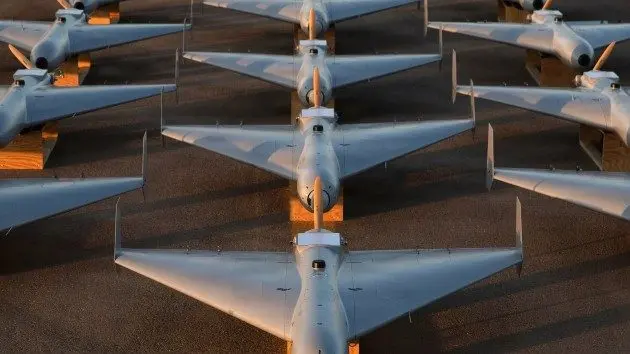The United States struck three nuclear sites in Iran on Saturday, plunging the U.S. into a pitched battle that has been waged over the past several days between Israel and Iran.
The full ramifications of the U.S. action, announced by President Donald Trump as “very successful” were not clear. Trump and his closest advisers had been weighing for days how to proceed, debating the costs of involvement and inaction. Democrats and some Republicans had already criticized the strike just minutes after it was announced.
Defense Secretary Pete Hegseth told reporters at the Pentagon on Sunday morning that the attack “devastated” and “obliterated” the Iranian nuclear program, describing the operation — named “Midnight Hammer” — as “bold and brilliant.” He added of Trump, “When this president speaks, the world should listen.”
Chairman of the Joint Chiefs of Staff Air Force Gen. Dan Caine also took part in the briefing, telling reporters that the seven B-2 bombers involved conducted the longest flight involving the B-2 fleet since 2001, refueling multiple times in-flight and linking up with escort fighter aircraft on their way east.
The bombers took off from Whiteman Air Force Base in Missouri, crossing the Atlantic Ocean and the Mediterranean Sea to reach the Middle East.
A total of 14 “bunker-buster” bombs known as MOPs — Massive Ordnance Penetrators — were dropped on the three sites at Fordo, Natanz and Isfahan, with the first two munitions dropped at 2 a.m., Caine said.
The attack also involved a U.S. submarine that launched more than two dozen Tomahawk land attack cruise missiles at what Caine called “key surface infrastructure targets” at Isfahan.
Iran did not deploy fighters or surface-to-air missiles during the mission, Caine said. “Throughout the mission, we maintained the element of surprise,” Caine said. “We are currently unaware of any shots fired at the U.S. strike package on the way in,” he added.
The chairman said the operation included deception and suppression tactics to ensure the safety of the U.S. aircraft. This included the use of decoys, “high speed suppression weapons” and “preemptive suppressing fires,” he said. More than 125 aircraft participated in the mission.
Caine said of extent of the damage caused by the U.S. strike, “I know that battle damage is of great interest. Final battle damage will take some time, but initial battle damage assessments indicate that all three sites sustained extremely severe damage and destruction.”
The 30,000-pound MOPs had never before been used in combat, but were expected to be able to tunnel 200 feet into the ground before exploding, a U.S. official said. The MOPs had been tested and were believed necessary to access underground nuclear sites like those at Fordo.
Hours earlier, sources told ABC News that B-2 stealth bombers, the only planes capable of carrying the MOP “bunker-buster” bombs, were headed to Guam. Caine said Sunday that those aircraft flew west to Guam as part of the Pentagon’s deception effort.
According to an Israeli official, the U.S. notified Israel ahead of the strike. Sources said House Speaker Mike Johnson was also briefed ahead of time. But other sources said that the full “Gang of Eight,”, including key Democrats, was not briefed until after the strikes. Some Democrats reacted harshly to the precarious military action in the volatile region, with New York Rep. Alexandria Ocasio-Cortez calling it “ground for impeachment” and that Trump was in in “grave violation of the Constitution” by not seeking congressional authorization.
‘Tremendous success,’ Trump says
Trump first announced the strikes on Truth Social, a move that surprised many given his statement on Friday that there was a “substantial chance” of negotiations.
“A full payload of BOMBS was dropped on the primary site, Fordow,” Trump posted on Truth Social. “All planes are safely on their way home.”
“There is not another military in the World that could have done this,” he added. “NOW IS THE TIME FOR PEACE! Thank you for your attention to this matter.”
Trump, who spoke to Israeli Prime Minister Benjamin Netanyahu, according a senior administration official, briefly addressed the nation.
“Our objective was the destruction of Iran’s nuclear enrichment capacity, and a stop to the nuclear threat posed by the world’s number one state sponsor of terror. Tonight, I can report to the world that the strikes were a spectacular military success,” Trump said in his address.
The president said that Iran’s key uranium enrichment sites were “completely and totally obliterated.”
And he warned Iran that it must now “make peace.”
“If they do not, future attacks will be far greater and a lot easier,” Trump said. Many targets inside Iran remain, Trump said. “But if peace does not come quickly, we will go after those other targets with precision, speed and skill.”
The Iranian Atomic Energy Organization condemned the strikes as “a heinous act in contradiction with the international law, especially the NPT.”
“This invasion occurred in violation of the international law, unfortunately amid indifference, and even companionship, of the IAEA,” the organization added.
Iran’s Foreign Minister Abbas Araghchi said in a post to X in the early hours of Sunday that the U.S. strikes on Iranian nuclear sites were “outrageous and will have everlasting consequences.”
“In accordance with the UN Charter and its provisions allowing a legitimate response in self-defense, Iran reserves all options to defend its sovereignty, interest and people,” he added.
Days of missile barrages
Israel and Iran have been exchanging missile barrages since Israel launched a preemptive strike against Iran’s nuclear program. Israeli officials said they felt Iran was getting too close to being able to produce a nuclear weapon.
Israel’s operation, “Rising Lion,” came after Israeli officials felt that Iran had enough nuclear material for several bombs, according to the Israel Defense Forces and an Israeli official familiar with the operation. In the initial preemptive attack, Israel hit the same three sites targeted by the U.S.
Several top Iranian nuclear scientists and the top general in the Islamic Revolutionary Guard Corps were killed in the operation, according to Iran.
In the wake of the Israeli strike on June 13, the two countries exchanged strikes daily, and Trump weighed whether or not to get involved. The U.S. was the only country with the plane — the B-2 — capable of carrying the MOP that could penetrate the mountain under which the Fordo centrifuge operation was hidden.
On Friday, Trump, who has long criticized U.S. involvement in overseas wars, said in a statement read by press secretary Karoline Leavitt that there was a “substantial chance” of negotiations. Trump gave the two-week time frame hoping Iran would “come to their senses.”
The White House said last week they felt that Iran had all of the materials it needed for a nuclear weapon and could produce one in a “couple of weeks.”
In March, Director of National Intelligence Tulsi Gabbard testified before Congress that Iran was not “building” a nuclear bomb.
The move, which many feared would draw the U.S. into a widening conflict, came just days after Trump said that he would make a decision about hitting Iran within two weeks.
Reactions pour in
The strikes sparked a range of reaction from American leaders.
House Speaker Mike Johnson lauded the move.
“The military operations in Iran should serve as a clear reminder to our adversaries and allies that President Trump means what he says,” Johnson wrote on X.
“The President gave Iran’s leader every opportunity to make a deal, but Iran refused to commit to a nuclear disarmament agreement,” he continued.
Similarly, Senate Majority Leader John Thune said in a statement that Iran “has rejected all diplomatic pathways to peace.”
“The mullahs’ misguided pursuit of nuclear weapons must be stopped,” said Thune. “As we take action tonight to ensure a nuclear weapon remains out of reach for Iran, I stand with President Trump and pray for the American troops and personnel in harm’s way.”
Sen. John Cornyn, R-Texas, said, “Trump made the courageous and correct decision to eliminate the Iranian nuclear threat.”
But Republican Thomas Massie wrote on X, “This is not Constitutional.” Democrats, including Sen. Bernie Sanders, joined the chorus.
“Not only is this news that I’ve heard this second alarming — all of you have just heard — but it is so grossly unconstitutional,” Sanders said at an event in Oklahoma. “All of you know that the only entity that can take this country to war is the U.S. Congress. The president does not have the right,” Sanders told the crowd at an event in Tulsa, Oklahoma.
Many within Trump’s own party were opposed to striking Iran and feared the consequences, including prominent MAGA podcaster and former Trump adviser Steve Bannon.
House Minority Leader Hakeem Jeffries said that Trump “misled” the country.
“President Trump misled the country about his intentions, failed to seek congressional authorization for the use of military force and risks American entanglement in a potentially disastrous war in the Middle East,” Jeffries said in a statement.
Fears at home and abroad
In the wake of the action, the NYPD deployed officers to sensitive locations and Israel tightened rules for public gatherings.
The Center for Internet Security, a nonpartisan think tank, in an assessment to law enforcement Friday, said, “Tehran is likely to leverage a combination of direct, proxy, and irregular/inspired forces to conduct physical, cyber, or terrorist attacks against U.S. interests both at home and abroad.”
The assessment said that in the wake of Israeli strikes, Iran would rely on “crude or escalatory tactics” and that the likelihood would increase with U.S. involvement.
ABC News’ Josh Margolin contributed to this report.
This is a developing story. Please check back for updates.
Copyright © 2025, ABC Audio. All rights reserved.





